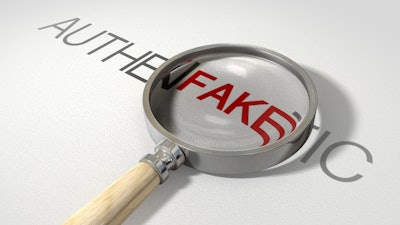
Manufacturers and Brand owners around the globe are in a fight against fakes. Counterfeiters are sabotaging companies' profits, and their ability to reinvest those gains into their business. The global pandemic is exacerbating the losses from counterfeiters, making it even more difficult to sustain business.
A study commissioned by the International Chamber of Commerce's (ICC) Business Action to Stop Counterfeiting and Piracy (BASCAP) and the International Trademark Association, estimates that the total global economic value of counterfeiting and piracy could reach $2.3 trillion by 2022. More than 25 percent of consumers have unwillingly purchased counterfeit goods online.
Unfortunately, diversion and counterfeiting affect everyone and all industries: high-end clothing and shoes or accessories like handbags and jewelry, automotive parts, or consumer electronics. Brand protection is essential not only to protect against the loss of revenue but to protect the brand owner’s image, reputation, and overall value. A faulty counterfeit that is mistaken for a legitimate product can significantly threaten a brand’s reputation. And research shows that customers change their buying behavior towards a brand in reaction to seeing fakes online.
Advances in technology have resulted in various packaging solutions to secure products from counterfeiters and diverters. Employing anti-counterfeiting intelligent label technologies have proven to be the most effective means of improving brand protection. Label marking, identification and tracking technologies have had the most significant impact on maximizing brand protection.
Security labeling technologies can be incorporated into the packaging itself and made to be part of the brand. Using security labeling for your packaging immediately confirms to the consumer that the product is not a fake and that no one has tampered with the product.
One such way is tamper-evident labeling, such as labels that “voids” or leaves a “checkerboard” pattern on the surface. Or, the frangible label that easily tears when someone attempts to remove it. Holograms that typically have a repeated static image are easily associated with a brand and add authenticity to the product when used on labels.
Other technologies include RFID labels, which are either passive (providing information) or active (recording information) and Near Field Communication (NFC) tags, which are a thin layer of material with an embedded antennae, radio chip and storage.
Leveling Up
Determining what type of security you require for your application is not always straightforward. A basic understanding of the available options is needed. When labeling a product and attempting to deter counterfeiting, there are two security levels to be employed: overt and covert. T
The first – overt – uses visible security technology. It is what you want the consumer and the counterfeiter to see and associate with the product. This overt security can be a static hologram or a decorative security seal over the package’s end. The paper that wraps around the top of salad dressing and the internal neck seal over the inner lid of a bottle are familiar examples. These labels are easy to read with the naked eye but are challenging to replicate, discouraging counterfeiters. Overt labeling enables fast and easy authentication by consumers and retailers when identifying product authenticity; however, they provide the least protection from counterfeiters.
The second level is covert, where the security measure may hide in plain sight or be hidden under the original label or inside the package itself. We have all had the experience of walking out of a store and heard an “alarm” sound. The alarm is triggered by an RFID or NFC tag sewn into the garment label or an electronic device inside the package. Because the consumer does not immediately notice it, it is considered a covert technology.
Along with a security label, a track and trace system verifies that the information on the label is valid and needed. Widely used in the pharmaceutical industry due to the enactment of the Drug Supply Chain Security Act (DSCSA), track and trace systems are now beginning to gain traction in consumer goods. Track and trace systems use unique product identifiers, such as serial numbers, to track individual products throughout the supply chain, from production to end consumers. It helps manufacturers significantly reduce counterfeiting by ensuring products can be easily identified. Modern track and trace are cloud-based systems and provide 24/7/365 access for product verification.
Next-Gen Solutions
In the past, most security applications solely used invisible or covert labels. Now, the most effective labeling technology solutions against counterfeiters are multi-faceted. They combine both overt/covert labels into the package decoration, incorporate unique holograms, leverage GS1 barcoding for serialization, and a smartphone to authenticate. The combination of holograms and barcodes creates an extra level of security, while the ubiquitous smartphone puts the power to determine if a product is real or not in the hands of the consumer.
Using their mobile device, consumers scan the label’s unique barcode, which reveals hidden information that is analyzed and validated to immediately determine the product’s authenticity. On the spot, the consumer knows whether the product is fake or not. The GS1 certified barcode allows the consumer to track and trace the entire trip the product took through the supply chain to get to them.
This type of multi-layer brand protection gives manufacturers the ability to protect against counterfeiters and improve everyday business services such as recalls, a return process, as well as new and sample product tracking. Another benefit of this intelligent labeling technology is the valuable insight it can provide to brand managers. The resulting data can help in developing market information for marketing campaigns and define the necessary supply chain components.
Each time a product is scanned, its location, and potentially the consumer’s location, are identified and stored in the cloud. With this information, brand managers can build and enforce a loyalty program, and ensure products are in the required locations to maximize sales potential while minimizing the risk of counterfeiting.
Ron Ducharme serves as Vice President of Business Development at Covectra, a leader in track and trace solutions. He can be reached at [email protected]





















